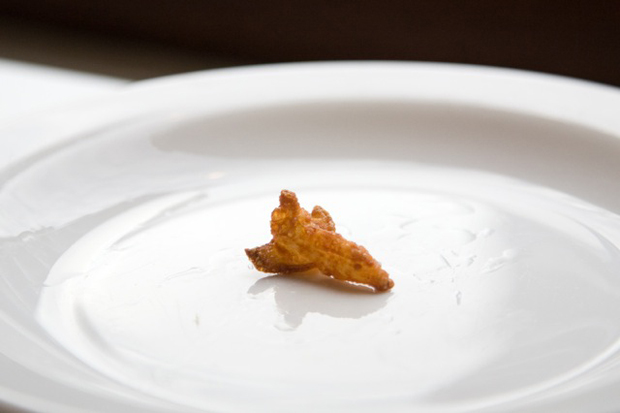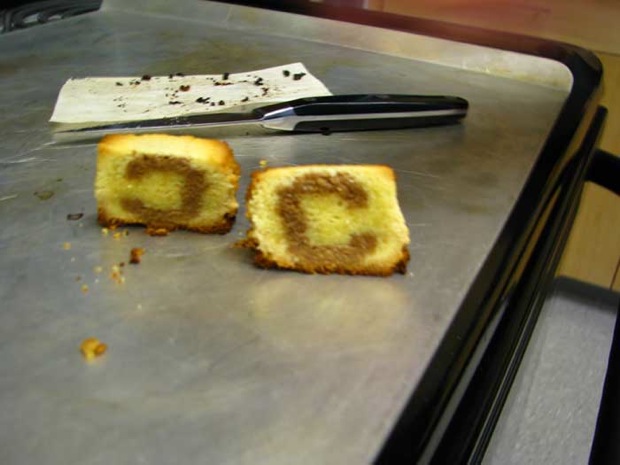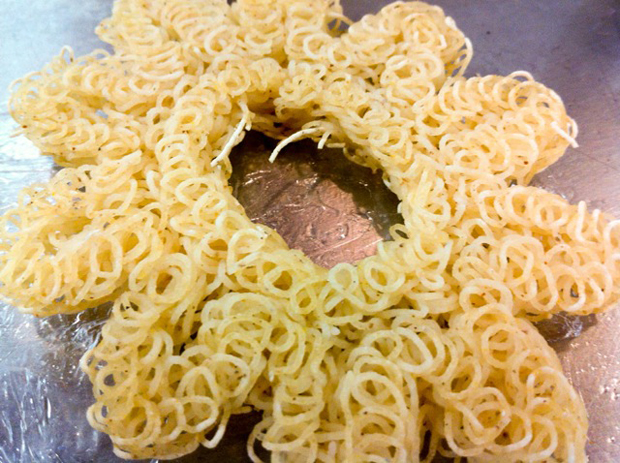The Cornell Creative Machines Lab wants to bring 3-D food printing technology to restaurants and home chefs. Top culinary talents believe this could lead to healthier diets, not just snazzier snacks.

Typically, 3-D printers are discussed in light of the efficiencies they bring to industrial design and fabrication. They will soon help chefs create foods that can’t be made by hand if Cornell Creative Machines Lab, or their peers in the industry, can make them accessible.
The newest 3-D food printer, now being honed at CCML, can produce: tiny space shuttle-shaped scallop nuggets (image above); and cakes or cookies that, when you slice into them, reveal a special message buried within, like a wedding date, initials (image below) or a corporate logo. They can also make a solid hamburger patty, with liquid layers of ketchup and mustard, or a hamburger substitute that’s made from vegan or raw foods.
The CCML food printers require edible inks and electronic blueprints called FabApps. This machine prints food using multiple cartridges, going line by line until the desired shape is extruded. "The electronic blueprint specifies exactly which materials go where--it is essentially a blueprint of the food item," says Hod Lipson, the head of the lab.

Other food printers, including those in prototype and design phases at MIT, could scan QR-code recipes.
With most 3-D food printing concepts today, the inks are the foods themselves in fluid form--think molten chocolate, cheese, or cookie dough. Foods that can’t be readily extruded from a syringe such as meats and vegetables are ground and mixed with other liquids to create novel food-inks.
While printing pyramids of pastry, or hemispheres of ham sounds whimsical, food printing is about more than decorative presentation. It’s a way to create new flavors and forms of food by varying its chemical properties. "It’s a huge 'design space,' and the combination of tastes and textures, geometries and colors that can be achieved is enormous,” says Lipson.
The head of the project at CCML, Jeffrey Ian Lipton, has developed a new printing technique that allows the printer to change the texture of the food being printed. Called stochastic printing or squiggle printing, the food buckles and coils as it comes out of the syringe instead of falling in a straight line. This results in very porous structures whose absorbent quality can be completely controlled.
Using corn masa dough, the lab team along with Chef David Arnold printed a new form of corn chip in the shape of a flower that could be deep fried evenly. "If it were solid you would burn the outside before the inside was fried," says Lipton. "By making it porous we can deep fry the whole thing at the same time. Therefore we can make much larger objects to deep fry."

Controlling texture finely means being able to change the texture of a single food material and have it be different in different parts of the shape. A tortilla could be made to go from crispy and dense on the edges to light and airy on the inside. "We can make an object softer, or stringy or absorbent," says Lipton. "You can get things to more evenly steam or deep fry, or hold more juices inside."
The Cornell group on the Fab@Home project has teamed up with the French Culinary Institute to create new foods and different forms of existing foods, with novel materials. Lipton believes that stochastic printing, leveraged with food printing will enable chefs to innovate and create new things that have never existed before faster, essentially allowing rapid prototyping of food.
"Foods that aren’t considered ‘food’ will become food in the future," says Homaro Cantu, executive chef at the Moto Restaurant in Chicago. He is exploring making foods look and taste like something they're not. "The fact is Americans will never give up their cheeseburgers and French fries, so we need to replace them with healthy raw ingredients. The home cook may never have the skill set to actually produce [the healthiest] foods-this is where food printing or what I call food transmogrification can step in and fill the void."
CCML's Lipton is working on finding more food materials whose properties can be altered to make them more delicious. The team’s efforts have caught the attention of many companies.
Essential Dynamics, a tech startup in New York, plans to bring out a commercial version of the 3-D food printer that will retail for $1,000 initially. Its founder Jamil Yosefzai believes that the desire to customize foods will make 3-D food printers an essential part of everyone’s kitchen in due course. “Customization of foods has played an integral role in our 250,000 year history,” says Yosefzai. "As time passes, 3-D food printing we will go from novelty…to utility…to indispensability."
CCML's Lipton added: "People like to play with food. They like to express themselves in food. This allows them to express themselves in not just what the food is made of, but what its shaped like. We can make health food more fun, interesting, and appealing with this technology. What kid wouldn't eat a space shuttle, even one made of peas?"
No comments:
Post a Comment